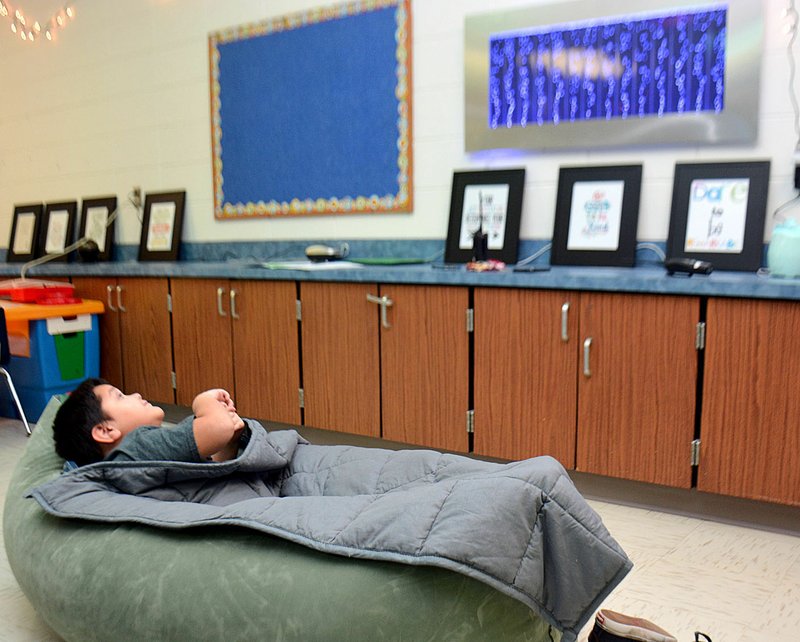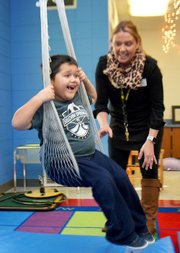SILOAM SPRINGS — Northside Elementary School installed a sensory room over the December break to give students a place to take a break.
The room is often used with special needs students who have autism or other sensory processing disorders, but it can also benefit students who are anxious or have experienced trauma, according to Principal Michelle Paden.
The room has 15 features that can be used to soothe students. Students can swing, jump on miniature trampolines or play with the sand table. They can lay down and cuddle in an inflatable pea-pod bed or under a weighted blanket, watch the bubble wall or crawl through a deep pressure roller. The room is calming with low lights, soft music and a scent diffuser.
Some students can become overstimulated by loud and busy situations, such as the lunchroom, a fire drill or an assembly.
“That’s a whole lot of sensory input for them that they can’t handle,” Paden said.
Sensory activities work by naturally stimulating the release of serotonin, an important brain chemical that is an overall body calmer, according to Kyle Sarratt, the school’s occupational therapist.
All the activities available in the room help release serotonin and calm the body, Sarratt said. Vestibular movement — movement that stimulates the middle ear — such as swinging acts as an amplifier that boosts all the calming effects of the other activities, he said.
Staff members keep careful records of which features a child used and what their behavior was like before and after their visit to the room so they know what works for each child, Paden said.
“Some may not need to jump, some may need the roller, some may need the weighted blanket,” she said.
Children gravitate most of the time toward the activity they need to calm their brain, Sarratt said.
“This room is perfect because you have everything available, and they can kind of regulate themselves,” he said.
Students spend an average of about 15 minutes in the room each session. The school has identified about 15 students who use the room on a regular basis, but there are also students who may use it after a stressful event, Paden said.
Staff members are very careful to communicate to children that the room is not for fun or a reward, but rather a place to figure out what their bodies and brains need, Paden said.
Barbara Macken, a behavioral specialist, said teachers follow very specific procedures before bringing a child to the room. Students have a social/emotional lesson and review the rules for the room before they visit.
Students are not brought to the room in the middle of a meltdown because staff members want it to be clear the room is not a reward for that behavior, Paden said. Instead, the goal is to bring them to the room when they start to feel anxious so they can get what they need before a meltdown.
“Our goal is to teach them to be an advocate for themselves and say ‘Hey I need a break,’” Paden said.
Many of the young students at the school, who range in age from 3 to 5, have difficulty understanding or expressing their own emotions, Paden said. They also don’t understand that it’s OK to be mad, but it’s not OK to hit a friend because they are mad, she said.
“One of the biggest things for me, for these little kids, is to let them know, ‘This is safe, it’s OK to have all of these big feelings, and we just help you know what to do with them and where to put them and how to handle it,’” Paden said.
Macken said she has seen many students using the techniques they learned, such as breathing, to calm themselves on their own.
“I have loved it,” she said. “I have seen some good things come out of it, just with the kiddos that come back, they seem more calm, they seem more prepared, and they’re talking more about ways to calm themselves.”


